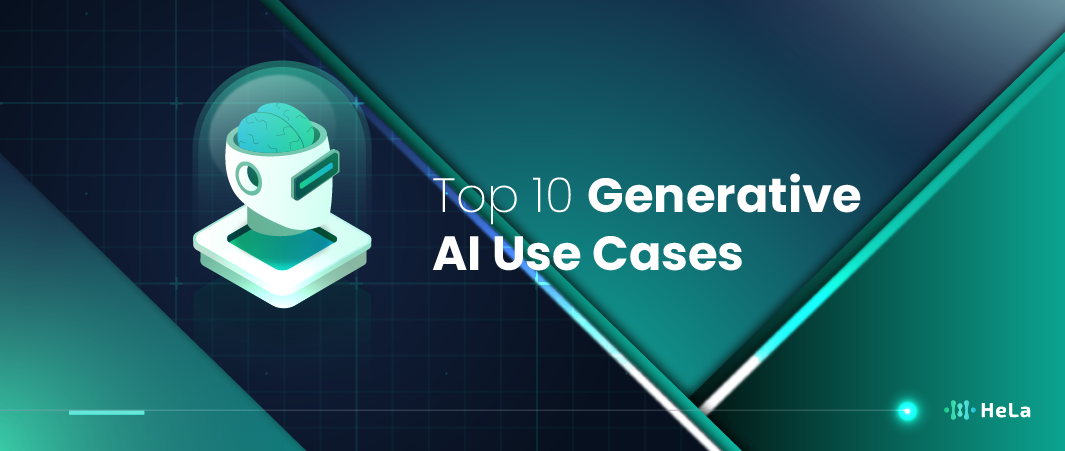This article delves into the top 10 generative AI use cases in 2025, shedding light on how this technology is being utilized to solve complex problems and drive innovation. Whether you’re in the tech industry or simply interested in the latest AI trends, understanding these use cases will provide valuable insights into the future of AI.
Generative AI has been at the forefront of technological advancements, pushing the boundaries of what’s possible in various sectors. As we move into 2024, the impact of generative AI is more profound than ever, transforming industries and redefining how we interact with technology. From creative endeavors to critical business operations, the use cases for generative AI are expanding rapidly.
Generative AI is not just a buzzword; it’s a powerful tool with real-world applications. In the following sections, we’ll explore these applications, along with other critical aspects of generative AI, to give you a comprehensive view of where this technology is headed.
Top 10 Generative AI Use Cases in 2025

Generative AI continues to expand its influence across various industries, offering powerful tools to enhance efficiency, drive innovation, and unlock new possibilities. From healthcare to finance and education to entertainment, the following use cases demonstrate the transformative power of generative AI. In 2025 and beyond, businesses and professionals are likely to witness even more advancements as AI-driven solutions become increasingly integral to modern operations.
1. Medical Image Interpretation
Generative AI is reshaping healthcare by providing advanced diagnostic support. AI algorithms are being developed to analyze medical images such as X-rays, MRIs, and CT scans, significantly improving the accuracy of diagnosis.
By identifying subtle anomalies that human eyes might miss, these systems assist radiologists and other healthcare professionals in detecting diseases earlier. For instance, AI can highlight potential tumor growth or detect early signs of diseases like Alzheimer’s. This combination of AI precision with human expertise reduces diagnostic errors and enhances patient outcomes.
2. Automated Medical Coding
In the administrative side of healthcare, generative AI is revolutionizing medical coding processes. Traditional manual coding for insurance billing and medical records is labor-intensive and prone to errors. AI-driven systems automate this process by analyzing medical records and assigning appropriate codes, drastically reducing time and errors. This leads to faster billing cycles and reduced administrative costs. In turn, healthcare providers can focus more on patient care rather than paperwork, while ensuring compliance with regulatory standards and minimizing financial losses due to coding mistakes.
3. Content Creation for Marketing
Generative AI tools have become indispensable in the marketing world. These tools create tailored content for advertising campaigns, social media posts, blog articles, and personalized email messages. By understanding consumer behavior and preferences, AI-generated content can engage audiences more effectively, leading to higher conversion rates. Companies can test multiple creative options quickly, optimize messaging based on performance data, and scale content production without exhausting human resources. As a result, businesses can maintain consistent and high-quality engagement with their customers while improving overall marketing efficiency.
4. Software Development Assistance
In software engineering, generative AI has become a valuable co-pilot for developers. Platforms like GitHub Copilot use AI to suggest code snippets, automate repetitive coding tasks, and provide real-time assistance as developers write code. This not only speeds up the development process but also helps reduce errors by offering code that adheres to best practices. AI-driven coding tools also lower the barrier for entry for new developers by providing suggestions and learning resources, enabling them to improve their skills more quickly. This ultimately leads to faster product development cycles and increased innovation within software teams.
5. Product Design and Prototyping
In the world of manufacturing and design, generative AI facilitates the creation of innovative products by enabling designers to explore a wide range of possibilities quickly. AI algorithms analyze design parameters and generate multiple design prototypes that meet specified criteria. This capability allows companies to identify optimal solutions without the need for extensive manual modeling.
By iterating through designs at high speed, businesses can reduce time-to-market and lower production costs while maintaining high standards of quality and creativity. This blend of AI innovation with human intuition is paving the way for groundbreaking products across various industries.
6. Financial Forecasting and Risk Assessment
Generative AI is playing a crucial role in the finance industry by enhancing decision-making processes. AI models simulate different economic scenarios, allowing financial institutions and businesses to assess risks and forecast financial performance more accurately. By analyzing historical data and predicting market trends, AI can generate insights that guide investment strategies and risk management decisions. These systems also help identify potential vulnerabilities in financial portfolios and offer recommendations to mitigate risks. The increased accuracy and speed of AI-driven financial analysis are reshaping how businesses plan and execute their financial strategies.
Also Read: 10 Best Software to Create NFT Art in 2025
7. Personalized Learning Experiences
In education, generative AI is revolutionizing how learning materials are created and delivered. AI-driven platforms tailor educational content to suit individual learning styles, pacing, and knowledge gaps. For instance, AI can generate quizzes, study guides, and interactive simulations based on a student’s progress, making learning more engaging and effective.
This level of personalization enhances student outcomes by addressing their unique needs and allowing for a more adaptive learning experience. As educational institutions continue to adopt AI, learners benefit from richer and more effective educational experiences, whether in classrooms or online learning environments.
8. Virtual Assistants and Chatbots
Generative AI is elevating customer service by powering intelligent virtual assistants and chatbots. These AI-driven systems can handle a wide array of customer interactions, offering instant, contextually relevant responses. From answering frequently asked questions to providing product recommendations and resolving customer issues, these chatbots enhance user experiences by offering 24/7 support. AI’s ability to learn and adapt over time ensures that virtual assistants improve in their accuracy and relevance with continued use. Businesses benefit from reduced operational costs while providing consistent and scalable customer service solutions.
9. Supply Chain Optimization
Generative AI is optimizing supply chain management by analyzing vast amounts of data to predict demand, manage inventory, and streamline logistics. AI-driven systems help companies avoid overstocking or stockouts by forecasting consumer demand with high accuracy. Additionally, these systems can identify inefficiencies within the supply chain, recommend optimal routes for distribution, and dynamically adjust inventory levels in real-time. As supply chains become more complex, generative AI enables companies to maintain resilience and efficiency while reducing costs, leading to better service delivery and stronger customer satisfaction.
10. Creative Arts and Entertainment
Generative AI is making waves in the arts and entertainment industries by co-creating with artists, musicians, and filmmakers. AI-generated music, artwork, and even movie scripts offer new avenues for creativity. These tools enable creators to experiment with styles, themes, and formats that they might not have considered, expanding the boundaries of artistic expression. In addition, AI-generated content can be used as a foundation for human artists to refine, remix, and build upon. This synergy between human creativity and AI-generated inspiration is unlocking new possibilities in storytelling, visual arts, and interactive media.
These examples illustrate just a glimpse of how generative AI is reshaping industries. As organizations continue to harness AI’s capabilities, the scope and impact of these technologies will likely expand further. The integration of AI into everyday operations, from healthcare to education and creative arts, signals a future where innovation and efficiency reach unprecedented levels, driving growth and progress in every sector. Generative AI’s potential is just beginning to unfold, promising transformative developments for years to come.
The Role of Generative AI in Creative Industries

Generative AI is playing an increasingly important role in the creative industries, from art and music to film and design. By automating certain aspects of the creative process, AI is enabling artists and creators to focus on the more human aspects of their work. This section explores how AI is being used in various creative fields and the impact it is having on the industry.
AI-generated art, for instance, is not just about creating something that looks good; it’s about pushing the boundaries of creativity. Artists are using AI tools to explore new styles, techniques, and concepts that would be impossible to achieve manually. In music, AI is composing original pieces, collaborating with artists, and even helping to create new genres.
The film industry is also seeing the benefits of generative AI, with AI being used to generate scripts, storyboard ideas, and even create visual effects. This is speeding up the production process and allowing filmmakers to experiment with new ideas and concepts.
Ethical Considerations of Generative AI
As generative AI becomes more prevalent, ethical considerations are becoming increasingly important. The ability of AI to generate content, art, and even data raises questions about authenticity, ownership, and the potential for misuse. In this section, we will discuss some of the key ethical issues surrounding generative AI.
One of the primary concerns is the potential for AI-generated content to be used for malicious purposes, such as generating fake news or deepfakes. This could have serious implications for trust and security in the digital age. Additionally, there are questions about the ownership of AI-generated content. If an AI creates a piece of art or writes an article, who owns the rights to that work?
Another ethical concern is the potential for bias in AI-generated content. AI systems are trained on large datasets, and if these datasets contain biases, the AI can reproduce or even amplify these biases in its outputs. This could lead to unfair or discriminatory outcomes in areas such as hiring, lending, and law enforcement.
How Generative AI is Transforming Business Operations
Generative AI is not just a tool for creativity; it’s also transforming business operations across industries. Companies are using AI to streamline processes, improve decision-making, and innovate faster. This section explores how businesses are leveraging generative AI to gain a competitive edge.
In manufacturing, for example, AI is being used to optimize production processes, reduce waste, and improve product design. By generating synthetic data and simulations, companies can test new ideas without the need for costly physical prototypes.
In the financial sector, generative AI is helping institutions manage risk and make better decisions. AI-generated models and scenarios allow companies to simulate market conditions and plan for different outcomes. This is leading to more informed decision-making and better risk management.
Customer service is another area where generative AI is making a significant impact. AI-powered chatbots and virtual assistants are handling more complex queries, reducing the need for human intervention and improving response times.
Also Read: 12 Best Blockchain-Based Automotive Startups in 2025
The Future of Generative AI: Trends and Predictions
As we look ahead to the future of generative AI, several key trends are emerging. These trends will shape the development and adoption of AI technology in the coming years. In this section, we will explore some of the most important trends and predictions for generative AI.
One of the most significant trends is the increasing use of AI in personalizing user experiences. From personalized content to tailored products and services, AI is helping companies create more customized experiences for their customers. This trend is expected to continue as AI technology becomes more sophisticated.
Another trend is the integration of AI with other emerging technologies, such as blockchain and the Internet of Things (IoT). This integration will open up new possibilities for AI applications, from secure data sharing to real-time analytics.
The use of AI in addressing global challenges is also expected to grow. From climate change to healthcare, AI has the potential to provide solutions to some of the world’s most pressing problems. As AI technology advances, we can expect to see more AI-driven innovations aimed at improving lives and solving complex issues.
Conclusion
Generative AI is no longer a niche technology; it is a driving force behind innovation across industries. From content creation to healthcare, AI is being used to solve complex problems and drive growth. As we move into 2025, the potential for generative AI is vast, with new use cases and applications emerging every day.
However, with great power comes great responsibility. The ethical considerations surrounding AI cannot be ignored, and it is crucial that we address these issues as the technology continues to evolve. Ensuring that AI is used responsibly and ethically will be key to unlocking its full potential.
In conclusion, generative AI is set to play a central role in the future of technology and business. By staying informed about the latest trends and developments, you can better understand how this powerful tool can be used to drive innovation and create value in the years to come.
Disclaimer: The information provided by HeLa Labs in this article is intended for general informational purposes and does not reflect the company’s opinion. It is not intended as investment advice or recommendations. Readers are strongly advised to conduct their own thorough research and consult with a qualified financial advisor before making any financial decisions.

Joshua Soriano
I am a writer specializing in decentralized systems, digital assets, and Web3 innovation. I develop research-driven explainers, case studies, and thought leadership that connect blockchain infrastructure, smart contract design, and tokenization models to real-world outcomes.
My work focuses on translating complex technical concepts into clear, actionable narratives for builders, businesses, and investors, highlighting transparency, security, and operational efficiency. Each piece blends primary-source research, protocol documentation, and practitioner insights to surface what matters for adoption and risk reduction, helping teams make informed decisions with precise, accessible content.
- Joshua Soriano#molongui-disabled-link
- Joshua Soriano#molongui-disabled-link
- Joshua Soriano#molongui-disabled-link
- Joshua Soriano#molongui-disabled-link

